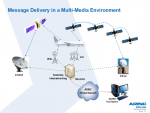Added known ground stations to our wiki
ACARS - The RadioReference Wiki
You have the list breaking up a section on software
Europe:
ACARS 131.525, 131.725 (primary in GB), 131.825
VDL2 136.725, 136.775,136.975 (primary in GB) and 136.875 (nothing noted on it to date here in GB but it's allocated for ground use)
Primary freqs in each case vary through the region
GB ground stations in Multipsk format, (others have been identified but I've not confirmed them)
10912A [EGPD Aberdeen/Dyce 57°12'N 002°12'W] [Aberdeen Dyce]
208B57 [EGPD Aberdeen/Dyce 57°12'N 002°12'W] [Aberdeen Dyce]
214A57 [EGPR Barra 57°00'N 007°30'W] [Barra]
212317 [EGBB Birmingham 52°30'N 001°48'W] [Birmingham]
216B45 [EGVN RAF Brize Norton 51°30'N 001°18'W] [Brize Norton]
229137 [EGPH Edinburgh 55°54'N 003°24'W] [Edinburgh]
230457 [EGLF Farnborough 51°18'N 000°48'W] [Farnborough]
23B025 [EGPF Glasgow 55°54'N 004°24'W] [Glasgow]
260825 [EGNM Leeds Bradford 53°54'N 001°42'W] [Leeds Bradford]
260F37 [EGLC London City 51°30'N 000°00'E] [London]
10919A [EGGW London Luton 51°54'N 000°24'W] [Luton]
11919A [EGGW London Luton 51°54'N 000°24'W] [Luton]
2651C5 [EGGW London Luton 51°54'N 000°24'W] [Luton]
2651D7 [EGGW London Luton 51°54'N 000°24'W] [Luton]
1091EA [EGKK London Gatwick 51°12'N 000°12'W] [Gatwick]
10988A [EGKK London Gatwick 51°00'N 000°12'W] [Gatwick]
11988A [EGKK London Gatwick 51°00'N 000°12'W] [Gatwick]
1191EA [EGKK London Gatwick 51°12'N 000°12'W] [Gatwick]
261EE1 [EGKK London Gatwick 51°12'N 000°12'E] [Gatwick]
261EF7 [EGKK London Gatwick 51°12'N 000°12'E] [Gatwick]
10983A [EGLL London Heathrow 51°30'N 000°30'W] [Heathrow]
11983A [EGLL London Heathrow 51°30'N 000°30'W] [Heathrow]
262242 [EGLL London Heathrow 51°30'N 000°24'W] [Heathrow]
262243 [EGLL London Heathrow 51°30'N 000°24'W] [Heathrow]
262257 [EGLL London Heathrow 51°30'N 000°24'W] [Heathrow]
262258 [EGLL London Heathrow 51°30'N 000°24'W] [Heathrow]
262259 [EGLL London Heathrow 51°30'N 000°30'W] [Heathrow]
10987A [EGSS London Stansted 51°54'N 000°12'E] [Stansted]
29D1D7 [EGSS London Stansted 51°54'N 000°18'E] [Stansted]
29D1D8 [EGSS London Stansted 51°54'N 000°18'E] [Stansted]
1099CA [EGCC Manchester 53°24'N 002°18'W] [Manchester]
2685D7 [EGCC Manchester 53°18'N 002°18'W] [Manchester]
29E737 [EGPO Stornoway 58°12'N 006°18'W] [Stornoway]
10993A [EGPU Tiree 56°30'N 006°54'W] [Tiree]


